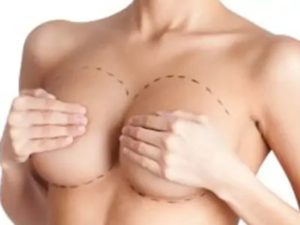Breast Reconstruction
 Also known as correction of prior or initial breast augmentation surgery, Breast Augmentation Revision surgery is performed on a patient who has already undergone a breast augmentation surgery but is unhappy with the results.
Also known as correction of prior or initial breast augmentation surgery, Breast Augmentation Revision surgery is performed on a patient who has already undergone a breast augmentation surgery but is unhappy with the results.
Common Indications
Some common indications (i.e., something that is considered advisable or necessary to undergo a particular test, medication, or procedure) for this procedure include the following:
- Asymmetrical breasts
- Capsular contractures (i.e., hardening and/or tightness of the breasts caused by excessive scar tissue)
- High riding breast implants (i.e., an excess of upper breast fullness)
Although asymmetrical breasts, capsular contractures, and high riding breast implants are all complications that may arise from initial Breast Augmentation procedures, the two that are of particular importance are capsular contractures and high riding breast implants. Capsular contractures are difficult to correct once formed, and must be carefully addressed by an experienced surgeon.
On the other hand, high riding breast implants is a common complication for Asians undergoing initial Breast Augmentation surgery, and a thorough understanding of the uniqueness of the breast anatomy and Asian tissue elasticity needs to be applied with an even more special surgical technique in order to correct this issue.
Surgical Procedure
Before surgery, Dr. Kenneth Kim will evaluate the patient’s concerns with a prior or initial breast augmentation surgery, the causes that may be leading to the patient’s unhappiness, and the best approach for Breast Augmentation Revision surgery during consultation.
Generally, the procedure will vary based on the patient’s individual needs, so each procedure for Breast Augmentation Revision surgery will be unique. Thus, it is better to make an appointment to meet with Dr. Kim in order to receive an accurate analysis of the approach that must be taken.
Some Advantages
- Correction of prior or initial breast augmentation surgery
- Correction of asymmetrical breasts
- Removal of excess scar tissue
- Correction of high riding breast implants
Some Disadvantages
- Risk of further damaging an already unstable and fragile breast anatomy
- Worsening of capsular contractures (i.e., hardening and/or tightness of the breasts caused by excessive scar tissue)
- Asymmetrical breasts
Surgical Duration
The duration of the surgery will vary based on the type of approach that is taken, but is typically from 1 to 3 hours.Anesthesia Options
Choice of anesthesia is given to the patient and the entire procedure may be done under local anesthesia (i.e., a method used by Dr. Kenneth Kim that numbs any sensation on and/or around the surgical site. This is often done through the direct injection of anesthesia at the surgery site and may be accompanied by one of the following:Mild Oral Sedative
Helps ease tension and relax the patient during surgery.Intravenous Anesthesia
A method used to render a patient temporarily sedated during surgery.General Anesthesia
A method used to render a patient temporarily unconscious, paralyzed, and intubated with a breathing tube during surgery.Recovery Time
The recovery time will vary based on the approach that is taken during this procedure. However, the general recovery time will be as follows:- Return to normal activity in 1 to 7 days
- Suture removal in 1 week
- Reduced swelling in 3 weeks to 1 month
Expected Results
The expected results will vary based on the approach that is taken for this procedure, but include the following:- Symmetrical breasts
- More flattering and natural breast shape and feel
Additional Information
Breast Augmentation Revision surgery is more difficult and involves more work than a prior or initial breast augmentation surgery, since the breast area has already been structurally destabilized and vital anatomic tissue has been distorted or damaged – meaning that a surgeon may have to structurally rebuild the breast tissue in order to produce desirable results. In short, Breast Augmentation Revision surgery often requires some level of reconstruction of the breasts. Complications that may arise from Breast Augmentation Revision surgery include the following: the possibility of excess scar formation, instability in the breasts’ structure, distortion of the breasts’ original anatomy, and damages in the breast tissue that are vital in supporting implants.Therefore, since Breast Augmentation Revision surgery is a more difficult procedure, it must be carefully planned and executed.











